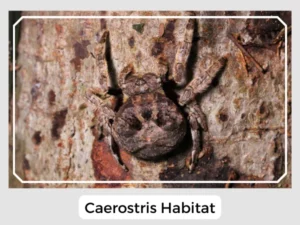The Caersotris, often called bark spiders, are part of the orb-weaver spider family. They call Madagascar and southeastern Africa their home. With nineteen known species as of April 2019, these spiders have a unique place in the spider world.
The eggs are round and lay protected in an egg sac, hatching in 2 to 3 weeks.
They remain with their mother for a while after being hatched and then disperse to dwell independently.
Their webs are strong and messy, resembling a spiral shape like most orb weaver species.
Yes, like most spiders, Caerostris spiders have venom. However, their venom is primarily used for immobilizing prey and is not known to be harmful to humans.
Caerostris spiders can bite if they feel threatened, but their bites are typically not dangerous to humans and are similar to a bee sting in pain level.
Caerostris spiders play a vital ecological role as biocontrol agents, regulating the population of small aquatic insects which they predominantly prey upon. Their behavior is adapted to their habitats near water bodies and swampy areas, where they can exploit the abundance of prey. The spiral webs serve not only as a hunting tool but also as a deterrent for potential predators.
Natural Predators: Despite their venomous defense, these spiders are not without predators. Birds, larger insects, and small mammals pose a threat, often preying on the spiders for sustenance.
Prey-Predator Dynamics: The Caerostris spiders’ interaction with their prey is a delicate dance of hunter and hunted. Their strong webs are strategic traps for unsuspecting insects, showcasing the intricate prey-predator dynamics within their habitat.
Relationship with Humans: Caerostris spiders have a benign relationship with humans, generally avoiding contact and residing in less-frequented areas. Their presence is often unnoticed, but they provide the service of controlling insect populations, a benefit that goes largely unrecognized.
| Lifespan | Approximately 1 year |
| Distribution | Madagascar and parts of southeastern Africa |
| Habitat | Close to water bodies, swampy areas |
| Diet | Small aquatic insects |

In conclusion, Caerostris spiders are key ecological players, intricately balancing their ecosystems with quiet diligence.
The Caersotris, often called bark spiders, are part of the orb-weaver spider family. They call Madagascar and southeastern Africa their home. With nineteen known species as of April 2019, these spiders have a unique place in the spider world.
The eggs are round and lay protected in an egg sac, hatching in 2 to 3 weeks.
They remain with their mother for a while after being hatched and then disperse to dwell independently.
Their webs are strong and messy, resembling a spiral shape like most orb weaver species.
Yes, like most spiders, Caerostris spiders have venom. However, their venom is primarily used for immobilizing prey and is not known to be harmful to humans.
Caerostris spiders can bite if they feel threatened, but their bites are typically not dangerous to humans and are similar to a bee sting in pain level.
Caerostris spiders play a vital ecological role as biocontrol agents, regulating the population of small aquatic insects which they predominantly prey upon. Their behavior is adapted to their habitats near water bodies and swampy areas, where they can exploit the abundance of prey. The spiral webs serve not only as a hunting tool but also as a deterrent for potential predators.
Natural Predators: Despite their venomous defense, these spiders are not without predators. Birds, larger insects, and small mammals pose a threat, often preying on the spiders for sustenance.
Prey-Predator Dynamics: The Caerostris spiders’ interaction with their prey is a delicate dance of hunter and hunted. Their strong webs are strategic traps for unsuspecting insects, showcasing the intricate prey-predator dynamics within their habitat.
Relationship with Humans: Caerostris spiders have a benign relationship with humans, generally avoiding contact and residing in less-frequented areas. Their presence is often unnoticed, but they provide the service of controlling insect populations, a benefit that goes largely unrecognized.
| Lifespan | Approximately 1 year |
| Distribution | Madagascar and parts of southeastern Africa |
| Habitat | Close to water bodies, swampy areas |
| Diet | Small aquatic insects |

In conclusion, Caerostris spiders are key ecological players, intricately balancing their ecosystems with quiet diligence.